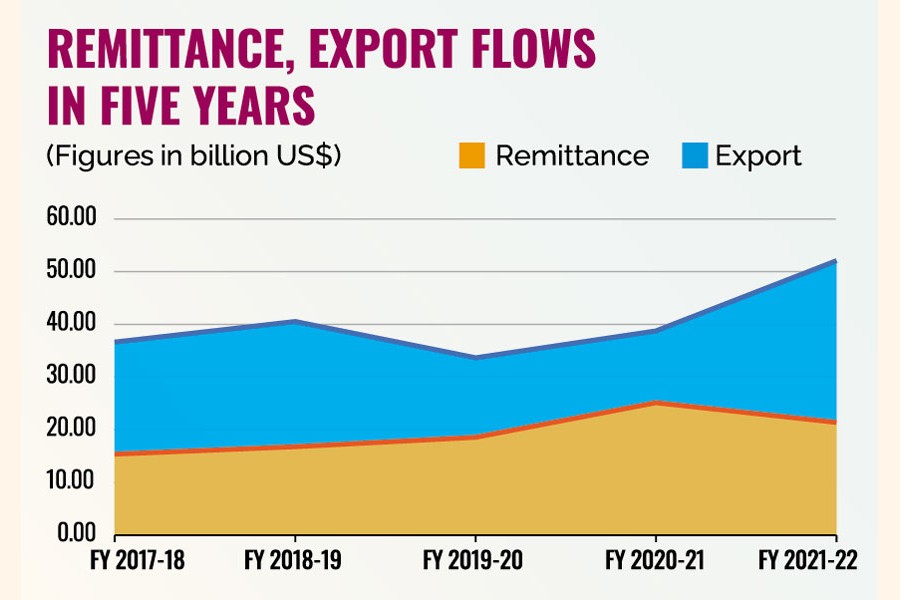
Bangladesh booked record goods export earnings at US$52.08 billion in the past financial year in a quantum leap by over 34 per cent as rebounded apparel shipments provided the prop.
Overall export earnings also surpassed the set target by 19.73 per cent in FY 2021-22, despite headwinds blowing from global crunch, according to Export Promotion Bureau data.
Exports fetched the country $38.75 billion during the July-June period of the previous fiscal year 2020-21, according to provisional trade data available with the EPB.
Of the total $52.08 billion worth of export income during the July-June period of the just-past fiscal, readymade garments (RMG) contributed the lion's share of $42.62 billion or about 82 per cent, the official count shows.
Leather and leather products crossed billion-dollar mark last fiscal while jute and jute goods, despite its negative growth, agricultural products and home textiles maintained their billion-dollar-earning benchmark.
Besides, the single-month export earnings in June last increased 37.29 per cent to $4.908 billion, after December high that amounted to almost the same amount at $4.907 billion.
Since September last, bar May this year, the country's single-month export earnings had surpassed the four-billion mark.
RMG-Bangladesh's single-largest export industry--in the last fiscal year posted a 35.47-percent year-on-year growth.
A breakdown of the clothing-sector performance shows that knitwear apparel earned $23.21 billion from exports, registering a 36.88-percent growth.
Earnings from export of woven garments amounted to $19.39 billion in FY'22, up by 33.82 per cent.
Home-textile exports also recorded over 43-percent growth to $1.62 billion in the last fiscal over $1.13 billion in fiscal 2020-21.
When asked, Bangladesh Garment Manufacturers and Exporters Association (BGMEA) president Faruque Hassan appreciated the RMG sector's performance as 'excellent'.
The sector's resilience during and after the pandemic, government's policy supports to run factories especially amid the Covid-19, buyers' confidence, and entrepreneurs and workers' contribution helped in netting the record earnings, he said.
"Exports increased both in terms of value and volume," he added.
He attributes huge work orders that came in the country, high prices of raw materials and other logistic costs to the rise in export earnings.
He, however, said in recent months work orders had fallen due to some external reasons, including high inflation across the world that dented consumer demand.
"But we believe that RMG-export earnings might reach $100-billion mark by 2030 if trend continues," the BGMEA president says, pinning his hope on some upgrading measures with added focus on product diversification, especially based on non-cotton items that cater latest fashion.
Demands for finished goods have increased after pandemic-pushed supply-chain disruption, says Leathergoods And Footwear Manufacturers and Exporters Association of Bangladesh (LFMEAB) adviser Saiful Islam.
"And Bangladesh with its social and political stability and production capacity gained buyers confidence that helped in achieving the growth," adds Mr Islam, also president of premier chamber MCCI.
He notes that Bangladesh should enjoy huge demand as buyers are reducing their dependence on single-country sourcing from China. Earnings from the sector would be much higher if the CETP is fully functional and ensures environmental compliance at Savar Tannery Park.
Talking to the FE, Bangladesh Terry Towel and Linen Manufacturers and Exporters Association (BTTLMEA) chairman Shahadat Hossain Sohel said home textiles also bagged huge work orders and the trend also continued.
Though Pakistan, one of the main competitors in home textiles, has also been flooded with work orders, Bangladesh's earnings from the sector might reach $2.0 billion within a couple of years provided stable energy situation is ensured.
He, however, feels that the performance could improve much if customs-related complexities are resolved.
Meanwhile, jute sector, which demonstrated a positive growth in the previous fiscal, recorded a 2.91-percent fall in the July-June period of FY 22 with $1.12 billion in earnings.
Earnings from agricultural items, including vegetables, fruits and dry foods, witnessed a 13-percent growth. The sector's aggregate earnings stood at $1.16 billion during the period.
Leather and leather products witnessed over 32-per cent growth to $1.24 billion in last fiscal against $941.67 million earnings in fiscal 2020-21.
The country fetched $795.63 million from engineering products exports in FY'22, which was $529 million in the previous fiscal.
Earnings from pharmaceutical exports stood at $188.78 million, marking an 11.69 per cent growth.
Export earnings from frozen and live fishes increased 11.64 per cent to $532.94 million during the same period.
According to the EPB, export of plastic products witnessed over 44-percent growth to $166.25 million.
© 2024 - All Rights with The Financial Express
